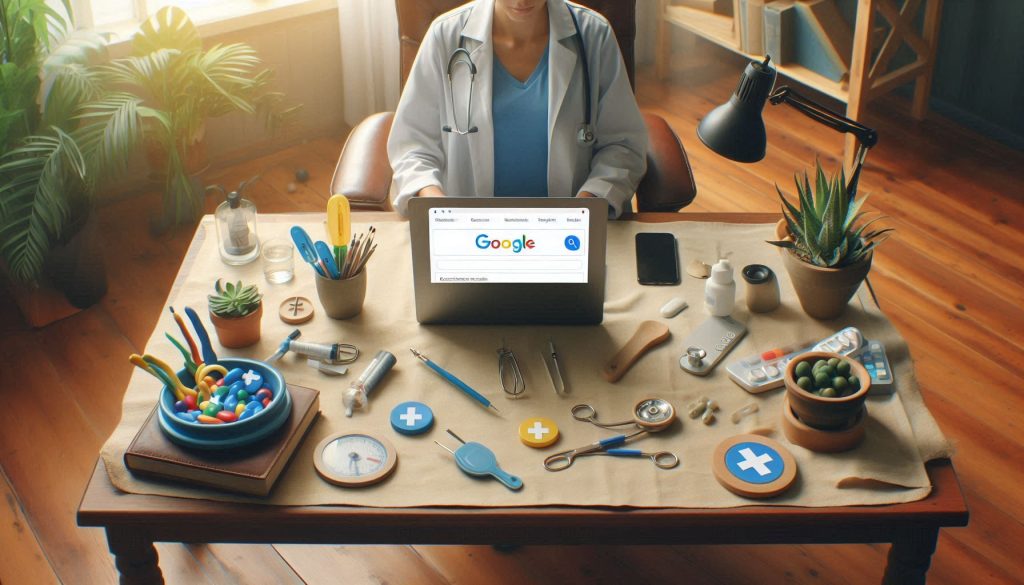In today’s digital landscape, the importance of reaching the right audience at the right time can’t be overstated, especially for therapy centers aiming to make a significant impact. Google Ads is a powerful tool that, when used correctly, can connect your therapy center with those in need of mental health services. However, navigating the complexities of Google Ads requires more than just basic knowledge; it demands a strategic approach tailored to your specific goals.
In this comprehensive guide, we’ll walk you through the essential steps to set up and manage a successful Google Ads campaign for your therapy center. From understanding the basics to crafting compelling ad copy, every aspect will be covered to ensure that your campaign not only reaches your target audience but also drives meaningful engagement.
Why Google Ads?
Google Ads is one of the most effective ways to reach potential clients who are actively searching for the services you offer. Unlike traditional advertising, where you’re casting a wide net and hoping for the best, Google Ads allows you to target specific keywords that potential clients are using to find therapy services. This means your ads are shown to people who are already interested in what you have to offer, increasing the likelihood of them taking action, whether that’s clicking through to your website or calling to book an appointment.
Step 1: Define Your Campaign Goals
Before you even log into Google Ads, it’s crucial to have a clear understanding of what you want to achieve with your campaign. Are you looking to increase the number of inquiries from new clients? Do you want to raise awareness about a specific therapy service you offer? Or perhaps you’re aiming to fill up your appointment slots for a new therapist joining your team.
Defining your goals upfront will guide every decision you make throughout the campaign, from the keywords you choose to the ad copy you write. For example, if your goal is to increase inquiries, you’ll focus on keywords and ads that encourage people to reach out. If you’re aiming for brand awareness, you might opt for broader keywords and ads that highlight your center’s unique approach to therapy.
Step 2: Understand Your Audience
Knowing your audience is the cornerstone of any successful marketing campaign, and Google Ads is no exception. Take the time to understand who your ideal clients are. What are their pain points? What keywords might they be using to find therapy services? Are they searching for help with anxiety, depression, relationship issues, or perhaps trauma?
Once you have a clear picture of your target audience, you can tailor your Google Ads campaign to speak directly to them. This includes choosing the right keywords, crafting compelling ad copy, and even selecting the geographic areas where your ads will be shown.
For example, if your therapy center specializes in anxiety treatment, you’ll want to target keywords related to anxiety, such as “anxiety therapist near me” or “anxiety counseling.” You can also use Google Ads’ demographic targeting options to reach specific age groups, genders, or even people with certain interests that align with your services.
Step 3: Conduct Keyword Research
Keywords are the foundation of any Google Ads campaign. They determine when and where your ads will appear, so it’s essential to choose them wisely. Start by brainstorming a list of keywords related to the services you offer. Think about the terms your potential clients might use when searching for therapy services online.
Next, use Google Ads’ Keyword Planner tool to expand your list and find additional keywords you may not have considered. The Keyword Planner will also give you an idea of how often people are searching for those terms and how much competition there is for each keyword.
When selecting your keywords, aim for a mix of broad and specific terms. Broad keywords, like “therapy” or “counseling,” will help you reach a wide audience, while specific keywords, like “cognitive behavioral therapy for anxiety,” will target people looking for a particular type of therapy. This combination ensures that your ads reach as many potential clients as possible while still being relevant to their needs.
Step 4: Set Your Budget and Bidding Strategy
One of the great things about Google Ads is that you have complete control over your budget. You can set a daily budget that works for your therapy center, and Google Ads will ensure that you never spend more than that amount.
When setting your budget, think about how much you’re willing to spend to acquire a new client. If each new client is worth $500 to your business, you might be willing to spend $50 or $100 to get them through the door. This figure will guide your daily budget and bidding strategy.
Google Ads operates on a bidding system, where you bid on keywords to determine how often your ads will appear. The higher your bid, the more likely your ad will be shown. However, it’s not just about the amount you’re willing to pay—Google also considers the quality of your ad and its relevance to the searcher.
There are several bidding strategies to choose from, depending on your goals. If you’re focused on driving clicks to your website, you might opt for a “Maximize Clicks” strategy, where Google automatically sets your bids to get the most clicks within your budget. If you’re looking to generate leads, a “Target CPA” (Cost Per Acquisition) strategy might be more appropriate, where you set a target cost for each new client, and Google adjusts your bids to help you reach that goal.
Step 5: Create Compelling Ad Copy
Your ad copy is what will ultimately convince someone to click on your ad, so it’s important to make it as compelling as possible. Google Ads gives you limited space—just three headlines and two description lines—so every word counts.
Start by crafting a headline that grabs attention and speaks directly to the searcher’s needs. For example, if someone is searching for anxiety counseling, a headline like “Professional Anxiety Counseling in [Your City]” will immediately tell them that you offer what they’re looking for.
In your description, highlight the benefits of choosing your therapy center. What makes your services unique? Do you offer flexible appointment times, a sliding scale for fees, or a particular therapy approach that’s especially effective? Make sure to include a clear call to action, such as “Call Today for a Free Consultation” or “Book Your Appointment Online.”
Remember to include your keywords in both the headline and description. Not only does this make your ad more relevant to the searcher, but it can also improve your ad’s quality score, which can lower your cost per click.
Step 6: Design Effective Landing Pages
When someone clicks on your ad, they should be taken to a landing page that is specifically designed to convert them into a client. This means your landing page should be relevant to the ad they clicked on, easy to navigate, and focused on a single call to action.
For example, if your ad promotes anxiety counseling, your landing page should provide more information about your anxiety therapy services, including what clients can expect, how to get started, and how to contact you. The page should also include a clear and prominent call to action, such as a phone number to call or a form to fill out to request more information.
A well-designed landing page can significantly increase your conversion rate, turning more clicks into inquiries and, ultimately, new clients.
Step 7: Set Up Conversion Tracking
To measure the success of your Google Ads campaign, it’s important to set up conversion tracking. A conversion is any action that you consider valuable, such as a phone call, form submission, or appointment booking.
Google Ads makes it easy to track conversions by providing a small piece of code that you can add to your website. This code tracks when someone completes a desired action after clicking on your ad, allowing you to see which ads and keywords are driving the most conversions.
By monitoring your conversion data, you can make informed decisions about where to allocate your budget and which aspects of your campaign to optimize.
Step 8: Launch Your Campaign and Monitor Performance
Once you’ve set up your Google Ads campaign, it’s time to launch it and start reaching potential clients. However, your work doesn’t stop there. To ensure the success of your campaign, you need to monitor its performance regularly and make adjustments as needed.
Start by keeping an eye on key metrics, such as click-through rate (CTR), conversion rate, and cost per conversion. If you notice that certain ads or keywords are performing better than others, consider shifting more of your budget toward those areas.
Don’t be afraid to experiment with different ad copy, keywords, or bidding strategies. Google Ads is a dynamic platform, and what works today might not work tomorrow. By continuously testing and optimizing your campaign, you can maximize your return on investment and keep your therapy center’s appointment book full.
FAQ 1. How can I ensure my Google Ads campaign targets the right audience?
Ans: To ensure your Google Ads campaign targets the right audience, start by clearly defining who your ideal clients are. Use Google’s demographic and geographic targeting options to reach specific groups, such as people in your local area or those searching for specific therapy services. Additionally, selecting the right keywords and crafting relevant ad copy will help attract individuals who are actively searching for the services you offer.
FAQ 2. How much should I budget for my Google Ads campaign?
Ans: The amount you should budget for your Google Ads campaign depends on several factors, including your therapy center’s goals, the competitiveness of your chosen keywords, and your target audience. It’s often wise to start with a modest budget, monitor performance, and adjust based on the results. Remember, Google Ads allows you to control your spending, so you can scale up or down as needed.
FAQ 3. What are some common mistakes to avoid when setting up a Google Ads campaign for a therapy center?
Ans: Common mistakes to avoid include neglecting to define clear campaign goals, choosing overly broad keywords that don’t target your specific audience, and failing to set up conversion tracking. Additionally, it’s important not to overlook the design of your landing pages, as these play a critical role in converting clicks into inquiries or bookings. Regularly monitoring and optimizing your campaign can help you avoid these pitfalls and ensure your ads are as effective as possible.
Suggested reading: An overview of the most effective digital marketing strategies for therapy centers
Conclusion
Setting up a Google Ads campaign for your therapy center is a powerful way to connect with potential clients who are actively seeking the services you offer. By defining your goals, understanding your audience, conducting thorough keyword research, and crafting compelling ad copy, you can create a campaign that drives meaningful engagement and helps your therapy center grow.
If you’re feeling overwhelmed by the process, or simply want to ensure that your Google Ads campaign is as effective as possible, consider partnering with experts who specialize in this area. Complete Gurus offers tailored Google Ads strategies designed to help businesses like yours achieve their marketing goals. With their help, you can focus on what you do best—providing exceptional care to your clients—while they handle the intricacies of your digital marketing campaign.

I am Ashutosh – a seasoned digital marketer, bringing digital transformation to businesses, complementing businesses’ growth via generating qualified leads, drive site inbound traffic via organic and inorganic approach, & build their brands through useful, well-designed marketing strategies and Marketing Automation implementation via Chat GPT, HubSpot & Zoho.








